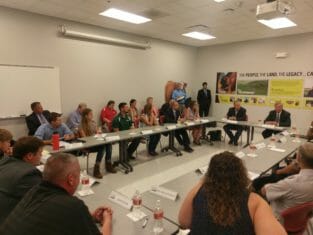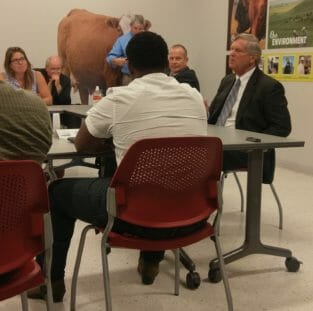Secretary of Agriculture Vilsack Hosts Roundtable with Beginning Farmers
Last week U.S. Secretary of Agriculture Tom Vilsack heard suggestions and challenges from 18 beginning farmers during a roundtable discussion. Eight Practical Farmers of Iowa beginning farmer members attended this event. Here is what they shared.
Beginning Farmers and Land Access
Each beginning farmer around the table had one thing in common – the challenge of accessing land. Some stories were similar, some were unique to the beginner’s situation, but they all expressed the need to make land more accessible for beginners. Kate Edwards, a beginning vegetable farmer near Solon, told the story of her discussion with her neighbor about such challenges, and the changes from when he bought his farm in the 1950’s for $150 per acre. With output prices being similar today as they were then she felt “There is no way I am going to cash-flow my business with those land prices.” With rising land prices beginning farmers can’t afford to purchase farm ground and there is no incentive for existing landowners to sell to them. Secretary Vilsack shared how it is a large income tax burden on landowners to sell land when they are living. He stated, “We need to find a way to incentivize landowners to sell to beginning farmers.” 
Cow/calf and row crop farmer Aaron White from Carlisle shared his story about how the Beginning Farmer Tax Credits helped him in securing 150 acres of crop ground to lease. Knowing how valuable this program is, Aaron remarked, “I think it would be a fabulous thing if all states would be able to create land access for their beginning farmers by giving tax credits to landowners.”
Specialty crop farmers have a tough time finding land, but how to finance that land can be even more challenging. Carmen Black purchased her CSA vegetable farm near Solon from her former 4-H leader, Susan Jutz: “A big challenge was figuring out how to buy the farm from this existing farmer, because we both had different financial situations. There is not a lot of precedent for a beginning farmer to buy an existing vegetable operation.” By talking with many individuals and organizations they were able to determine a contract agreement to purchase the farm and the vegetable business.
Women in Agriculture
Secretary Vilsack spoke to the group about the USDA’s focus on supporting women in agriculture. He asked women farmers at the table to send suggestions and stories to the newly created e-mail address, agwomenlead@usda.gov. Kate Edwards shared how having a successful woman farmer mentor played an important role in her ability to farm. Carmen Black agreed with this sentiment. She told him, “Supporting women on the farm will inspire young women to believe it is possible.”
Using USDA Programs
Naturally the use and availability of USDA programs was talked about across the entire group. Each of the PFI members there have used or are currently using USDA programs. USDA lending programs helped Kate Edwards when she was relocating her farm.
In some cases USDA programs came with obstacles. Jason Kerr, who raises blueberries near DeWitt, was pleased to hear that he could obtain coverage for his crop through the Noninsured Crop Disaster Assistance Program (NAP). When he went into his local USDA office they weren’t familiar with how to enroll blueberries under this program. Because blueberries aren’t a common crop in Iowa they lacked the data for yield and pricing. Jason recalled, “In my case I was given yield and pricing which was based on juice blueberry production data from Florida.” Others shared similar stories to Kate and Jason, and agreed understaffing and paperwork at the USDA offices generated hurdles when seeking support through these programs.
The Conservation Reserve Program (CRP) surfaced many times across the table. Some saw soil conservation benefits through this program, while others saw complications the program created. Nathan Anderson, who raises cattle and field crops near Cherokee, struggled with trying to use the Transition Incentives Program (TIP) to purchase CRP ground from a retiring farmer. He would like to see some refinement done to make programs like this more accessible for farmers.
Nathan also spoke about struggles he had while serving as a county Soil and Water Commissioner to establish a priority ranking system for cost-share programs: “This system allowed us to target cost-share on land that needed it most, and also on land where farmers were using management practices to preserve soil and water.” He then shared, “We had to abandon that program because we didn’t have NRCS staff on the ground to implement the ranking system.”
Sharing challenges with others can be a difficult conversation to have. These beginning farmers have done just that to assist in making farming a little easier for the next generation. We are lucky to have a great network of beginning farmers at Practical Farmers of Iowa!
